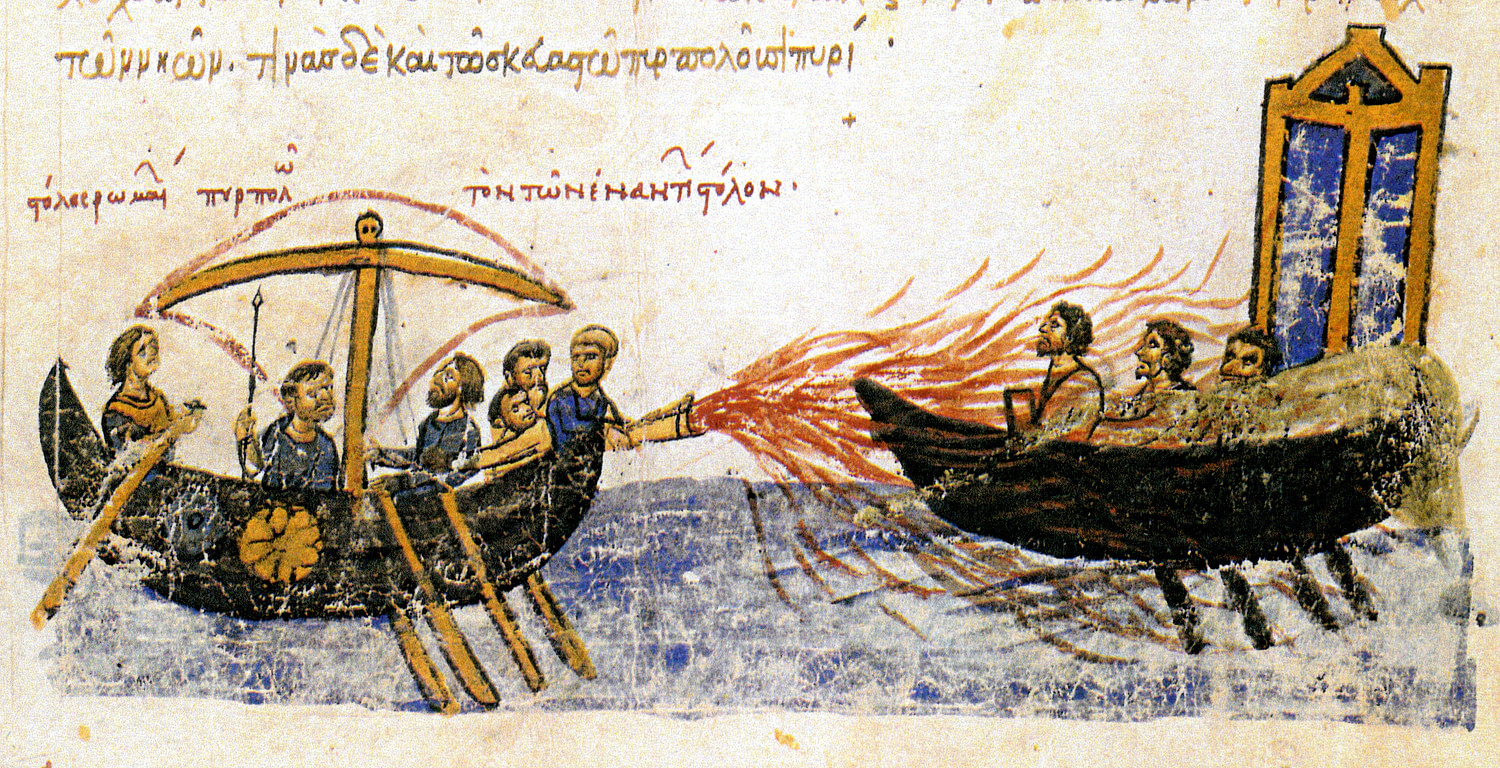The Urge To Kill
The stage is the ancient Greek Capital Constantinople. The period is set somewhere in the 7th century. The protagonists on stage are the mighty Byzantines. The antagonists are the equally enthralling Arab empire. The plot as any medieval war story would, revolves around the conquest of power. The power that led an entire dynasty into nothingness, the power to control the central hub of all Asian ports, Constantinople (present-day Istanbul). The invasion of the Arab conquerors had shoved the Byzantines into a small corner and the city of Constantinople was their last hope, both to survive and thrive. The battle of seas commenced and surely fate would have the Arabs complete their conquest.
The plot twist? The Greek fire.

https://www.worldhistory.org/img/r/p/1500x1500/7616.jpg
The first wave of fear hit the Arab fleet when they saw the sea burn alive, and the second hit when their comrades burnt next. The first chemical weapon of mass destruction. Years of research have concluded its primary ingredients to be either petroleum or naptha but its exact composition to this date is unknown. But what we do know is that it lit the entire sea on fire the second it touched water. The credit for its invention goes to Callinicus Heliopolis, a Greek-speaking Jewish refugee who had fled the Arab conquest of Syria and now served his new motherland, Constantinople
13 centuries pass.
The stage is the Belgian battleground Ypres. The year is 1915. The protagonist on stage is the 4th Army battalion of the German troops. The antagonists are the combined Allied powers which included the French, Canadian, and British troops. The plot, 1300 years later remains the same, the conquest of power. Power to rewrite history, power to conquer the world. This isn’t any war we’re talking about; this is World War I. Capturing the tactical high ground that Ypres possessed would decide the fate of the battle and the odds were heavily favouring the combined Allied powers.
But then again there was another plot twist, Chlorine gas

https://www.historycrunch.com/uploads/4/1/1/6/41169839/second-battle-of-ypres-gas-ww1_orig.jpg
On 22 April 1915 at about 5:00 p.m., the French army was welcomed with 171 tonnes of Chlorine gas. Soldiers watched from a distance as a yellow wall breached their trenches, soldiers watched from a distance as the yellow cloud swallowed the ones in front, but then soldiers could no longer watch once the yellow gas blinded their sight. That evening the air in Ypres smelled like acid. As soon as the German troops saw the French battalion struggling, they charged with every man. Ypres turned ugly. Every man for himself, the French ran, cried and when no one was left to hear their battle cries, they died. Terror gripped every soldier as their fingers clutched onto their rifles, but every single one of them knew guns were useless against the yellow wall. But this did not happen overnight, this was the result of several months of planning prior, and the mastermind behind it? Fritz Haber, a Jewish Chemist who was prepared to die for his Fatherland, Germany
Their relevance?
On 22nd April 1915, Chemical warfare was born, and Fritz Haber? The Father of Chemical Warfare.
Chemical Warfare
A form of warfare where the toxic properties of chemical substances are used as weapons of mass destruction, chemical warfare is different from all other forms of warfare in the sense that they can be catered specifically to either kill, harm, or paralyze opposing forces. These chemical weapons can take all three forms of matter and inflict damage when inhaled, absorbed through the skin, or ingested in food or drink. These chemicals are specifically designed to maximize the potential damage they could inflict on human beings or any living organism for that matter. The thought of artillery shells, rockets, aerial bombs, and missile warheads is often associated with fear, right? But what about the chemical agents meticulously curated within them to perform the killing?
Let’s look at these chemical agents a little closely. We can broadly categorize them into 5 types.
Choking agents: Choking agents primarily target the respiratory system. They are often delivered as gas clouds to the target area and targeted persons come in contact with the agent through inhalation. The toxic agent then triggers the immune system, causing fluids to accumulate in the lungs, making it difficult for victims to breathe, and if not treated promptly can even lead to death through asphyxiation or oxygen deficiency. Choking agents were first deployed as a lethal weapon during WW1 and the most sought-after ones were chlorine and phosgene. They are colourless and volatile and hence the enemy can never be prepared for such an attack.
Nerve agents: Considered one of the deadliest chemical weapons ever created, this class of chemical agents poses a serious threat to human life. Their method of operation revolves around the disruption of the entire nervous system. This is done by inhibiting the action of acetylcholinesterase (AChE), an enzyme that regulates the transmission of nerve signals. The symptoms of nerve agent exposure include excessive sweating, pinpoint pupils, muscle twitching, convulsions, loss of consciousness, and death. The most commonly used nerve agents are Sarin (GB), Tabun(GA), Soman(GD) and VX

https://www.mdpi.com/molecules/molecules-26-04631/article_deploy/html/im...
Blistering agents: Blistering agents, also known as vesicants are a class of chemical warfare agents designed to specifically target the skin, eye, and respiratory tract. Their primary characteristic symptom as their name suggests is the large painful blisters they produce. Blister agents are liquids that can form a vapor that floats into the air. Victims often come in contact by either directly touching a liquid blister agent or inhaling the vapor. The most well-known and extensively used blister agent in warfare is sulphur mustard, also known as mustard gas. Depending on the level of exposure and the net concentration they can designed to kill or incapacitate the approaching enemy.
Blood agents: Blood agents serve as another chemical warfare agent whose primary goal is to disrupt the normal functioning of the respiratory and circulatory system, but the catch is that they are 10 times more lethal. They are generally cyanide or arsenic-based and are delivered to the targeted area in the form of a vapor. When inhaled, these agents interfere with the ability of the body to transfer oxygen to cells, causing the body to asphyxiate. These chemicals block the enzyme that is necessary for aerobic metabolism, thereby limiting the supply of oxygen to red blood cells, which has an immediate effect similar to that of carbon monoxide. The most prominent blood agents include Hydrogen cyanide (HCN) and cyanogen chloride (CNCl).
Irritants: Not all agents are meant to kill, some are meant to stall for time and these are the warfare agents specially curated to do so. They are designed to cause temporary irritation and discomfort to the eyes, nose, throat, and respiratory system without necessarily causing severe injury or death, to incapacitate, disorient, or paralyze opponents. These agents are used primarily for their incapacitating and psychological effects, as they force confusion and paranoia within the enemy troops. The most commonly used irritants are Tear gas and vomiting agents
The Aftermath
After the second battle of Ypres, both the Allies and the Axis powers realized the boundless potential that these chemical weapons possessed and hence, a mass production ensued. The result was horrendous. More than 90,000 soldiers never woke up from these poisonous gases and a million more were blinded for life. The damage inflicted by these gases was so dreadful that the Great War is often labelled the “Chemists’ War.” As a response to the horrors of chemical warfare during World War I, the Geneva Protocol was established by the League of Nations in 1925 for the Supervision of International Traffic in Arms. This international treaty prohibits the use of chemical and biological weapons in warfare. However, the Geneva Protocol still had a loophole within it.
While the Protocol banned world powers from using chemical weapons in warfare, it never said anything about producing and stockpiling them. As a result, countries continued producing chemical weapons for decades as a symbol of power and dominance. However, the Geneva Protocol succeeded in one thing, effectively stigmatizing the use of chemical weapons in warfare. Even the Nazis who produced and stockpiled lethal nerve agents such as Sarin and Tabun never used them in actual battlefield. Nevertheless, war is war and when it comes to a matter of life and death no protocol will make a difference with a weapon in hand

https://www.opcw.org/themes/custom/opcw/graphics/logos/2020/blue/opcw-en-2x.png
All this ultimately led to the establishment of The Chemical Weapons Convention (CWC) on September 3, 1992. It serves as a multilateral disarmament treaty that prohibits the production, stockpiling, and use of chemical weapons and their precursors. Additionally, the treaty also made sure to include provisions for the destruction of existing chemical weapon stockpiles, verification of compliance, and assistance and protection for victims of chemical weapons incidents. CWC has thus played a vital role in controlling Chemical Warfare on a global stage
“War does not determine who is right - only who is left.” – Bertrand Russel
And what will be left of us when we are in this race to see who gets to kill first?
References:
https://sciencehistory.org/stories/magazine/a-brief-history-of-chemical-war/
https://www.britannica.com/technology/chemical-weapon
https://www.iwm.org.uk/history/what-you-need-to-know-about-the-second-battle-of-ypres
https://www.ancient-origins.net/artifacts-ancient-technology/greek-fire-0017989


